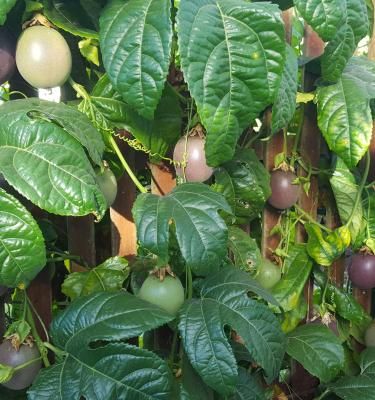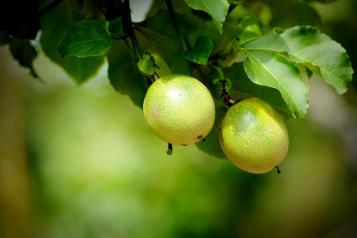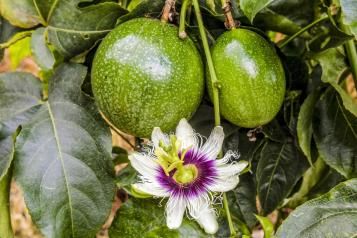

How to grow passionfruit in New Zealand
Passionfruit represents the sweet taste of summer and autumn months in New Zealand. A bright green vine with striking flowers, the passionfruit plant does more for our gardens than produce a scrumptious seedy fruit.
While it’s popular throughout the country and a hardy survivor in most climates, passionfruit vines are tropical and require maintenance. Get our top tips on growing passionfruit in New Zealand with our comprehensive guide.
When to plant passionfruit in New Zealand
When growing passionfruit for the first time, you’ll want to plant from mid-spring to mid-summer when the soil is warmer. It should begin fruiting around 18 months after planting.
- Plant passionfruit– October to May
- Harvest passionfruit– February to June
Passionfruit varieties to grow
There are many popular passionfruit varieties in New Zealand. Some are self-fertile – meaning they can produce fruit on their own – whereas others need to cross-pollinate with other plants to fruit.
Some popular passionfruit varieties in New Zealand are:
- Purple passionfruit (Passiflora edulis): The most popular commercially grown passionfruit variety in New Zealand. Black Beauty is a self-fertile purple passionfruit that grows well in gardens.
- Giant Granadilla (Passiflora quadrangularis): Great for a gardening option, this self-fertile vine bears large green or yellow fruit.
- Yellow passionfruit (Passiflora edulis v. flavicarpa): This variety offers slightly smaller fruit and is less tolerant of cold winters. It also needs to cross-pollinate in order to fruit.
- Gold passionfruit hybrid (Passiflora edulis v. flavicarpa x edulis): The gold passionfruit is a cross between the purple and yellow variety and appears to handle the New Zealand climate well.
Note: Banana passionfruit vines are common in northern New Zealand gardens and bushes. While edible, they are considered a noxious weed and are illegal to propagate.

Planting your passionfruit vine
Passionfruit vines can grow in different climates and conditions. However, the best results will come from a frost free position with plenty of sun, shelter from the prevailing wind and light to heavy sandy loam soil that drains well and is rich in organic matter.
October to May is the best time of year to plant your passionfruit vine. Early morning or late evening are the best times of day to plant your passionfruit vine, particularly in hot weather, to reduce its vulnerability.
You should also check any specific planting instructions available on the label for your plant, as the different varieties do have slightly different needs.
To plant your passionfruit:
- Choose a spot to plant your passionfruit that drains well, is sheltered from wind, and provides full sun – or partial shade in very hot areas. Ideally, it should be next to a structure the vine can climb up.
- Apply Scotts Sheep Pellets to the ground to improve the quality of your soil and give your passionfruit plant the best conditions for growth.
- Dig a hole around twice the width and depth of the pot your passionfruit plant is currently in and place the plant in the centre.
- If you aren’t planting your passionfruit by a structure, prop up the vine with bamboo or pine stakes using soft ties.
- Fill the hole around your plant with soil.
- If you’re planting in a colder area or outside of the warmest months of the year, you may like to add a layer of mulch around the base of the plant to support root growth.
- Water your passionfruit vine well.
Note: If you’re planting more than one passionfruit – for example, you plan to cover a large trellis or wall – plant them a minimum of two metres apart from each other.
Growing passionfruit in pots
Passionfruit is a great fruit to grow in pots. You’ll just need to use a structure or stakes to support the vine.
To grow your passionfruit in a pot:
- Choose a medium or large pot with drainage holes so your vine has plenty of room to grow.
- Fill the pot with Scotts Osmocote Citrus & Fruit Potting Mix.
- Plant your passionfruit in the centre of the pot, then fill the space with soil and pat it down to keep it firmly in place.
- Prop up the vine with bamboo or pine stakes using soft ties.
- Water your newly potted passionfruit and place in a sunny spot sheltered from the wind.
Planting passionfruit seeds
Seed-grown passionfruit can be ready to harvest in 18-24 months. However, not all seeds will germinate and may need extra care as young seedlings, and hybrid varieties grown from seed may be variable.
To grow your passionfruit from seed:
- Fill a well-draining pot or container with Scotts Osmocote Citrus & Fruit Potting Mix.
- Plant passionfruit seeds approximately 1cm deep (note you will need to transplant them into separate pots as they grow). You can fit between 2-3 seeds into a small pot. For larger containers you can space them 5cm apart from each other.
- Place the container in a warm, sunny spot indoors.
- Keep the soil moist, but not drenched. You may want to cover the top of the container with cling wrap to help lock in the moisture.
- When the seedlings are about 20cm tall, you can plant them out into the garden or into pots outside.
Passionfruit tree care
Passionfruit plants will need protection from wind and temperature extremes. They need watering often, especially during summer months to support fruit production.
Don’t have time for regular watering? During dry periods, apply Scotts Osmocote Mulch & Feed around the base of the plant to keep roots moist. This will also add a layer of warmth in colder temperatures.
Remove any dead leaves or passionfruit flowers as necessary. During winter, the passionfruit may further lose some leaves but the vine won’t die off.
Fertilising your passionfruit
It’s a good idea to feed your passionfruit plant at the start of spring.
Use Scotts Osmocote Controlled Release Fertiliser for a ‘set and forget’ plant food designed to support fruit yields and minimise your gardening to-do list.
When to prune passionfruit in New Zealand
Passionfruit don’t typically require hard pruning, as they will fruit on new growth. Give your passionfruit a trim in early spring (September onwards) after hard frosts have ended to encourage growth
When pruning, trim approximately one third of the vine back. Keep your vines healthy over autumn by removing weak or dead vines, leaves and flowers. This supports air circulation and helps prevent disease.

Harvesting passionfruit
Passionfruit produces fruit from mid-summer through to autumn. Fruit takes approximately 2-3 months to ripen.
Pick your fruit when the colour on the outside is true to your variety (purple, yellow or gold), and when it falls easily off the vine.
The best time to pick your passionfruit is in the morning, before the hottest part of the day.
Struggling to bear fruit? Bad weather may cause problems for pollination. Give your passionfruit the best chance by planting attractive flowers around the vine for pollinating insects. It’s important to shelter your passionfruit vine from harsh conditions where possible.
Top tips for growing passionfruit
- Many passionfruit varieties are self-fertile – which is a great option if you only plan planting one passionfruit vine.
- Apply mulch to protect your passionfruit against colder temperatures and keep the roots damp during dry periods, reducing your need to water it regularly.
- Passionfruit requires a structure like stakes, a trellis, a wall or deck to support the vine.
- Check planting instructions on any label that comes with your passionfruit, as different varieties have different environmental needs.
Frequently asked questions
Do passionfruit vines die off in winter?
No, passionfruit vines continue growing through winter, although growth may slow down. In colder months, protect from frost and remove dead leaves and flowers from the vine to keep it healthy.
When is the best time to plant passionfruit?
Spring through autumn is the best time to plant your passionfruit in New Zealand. Between October to May, the soil is still warm and can encourage growth before colder temperatures set in.
Where should you plant passionfruit?
The best conditions for planting passionfruit in New Zealand are in a sunny spot sheltered from the wind. In hotter areas, consider planting your vine in a spot with some shade to relive the plant from intense sunlight. Plant near a wall or trellis to support the vine.




